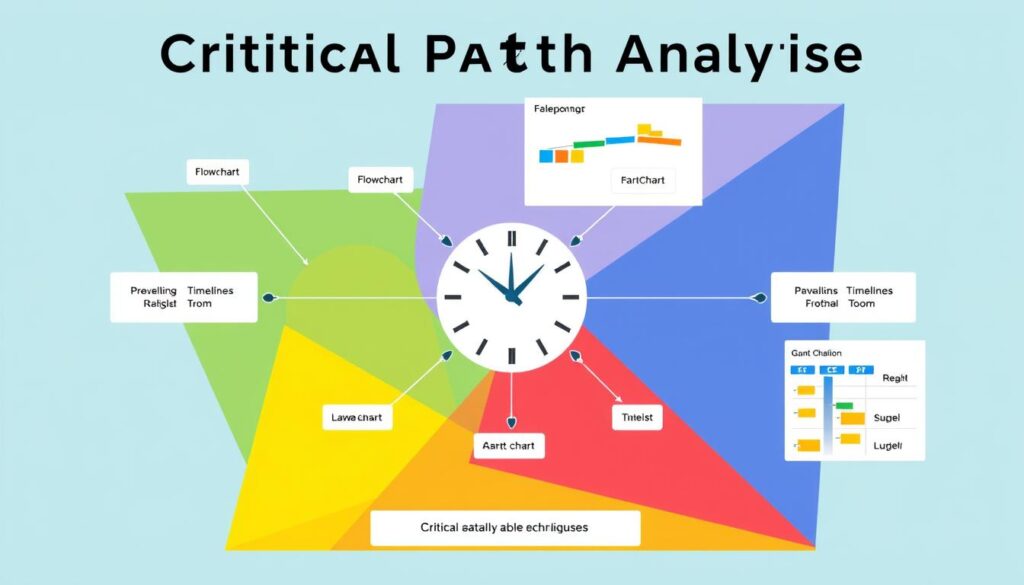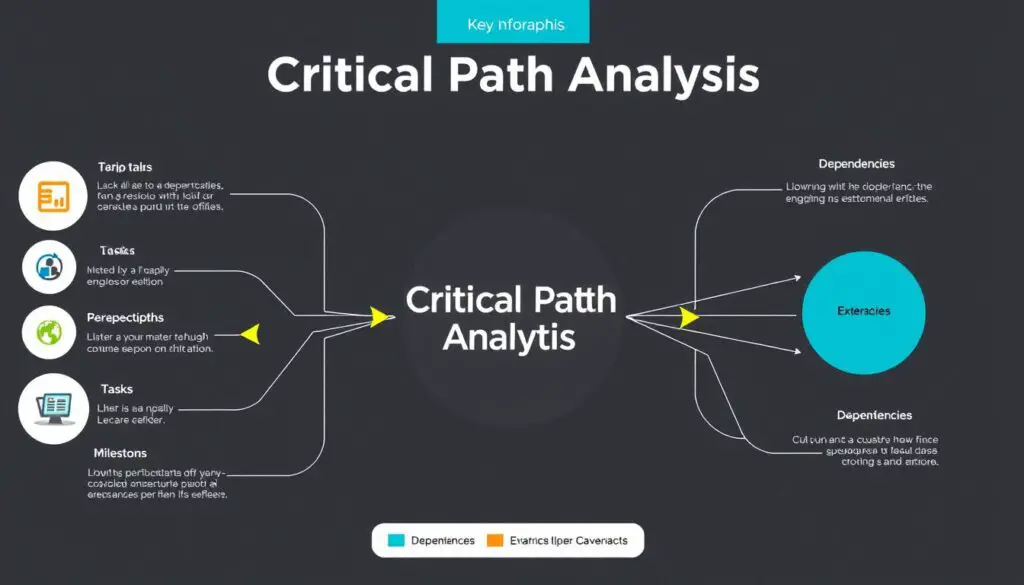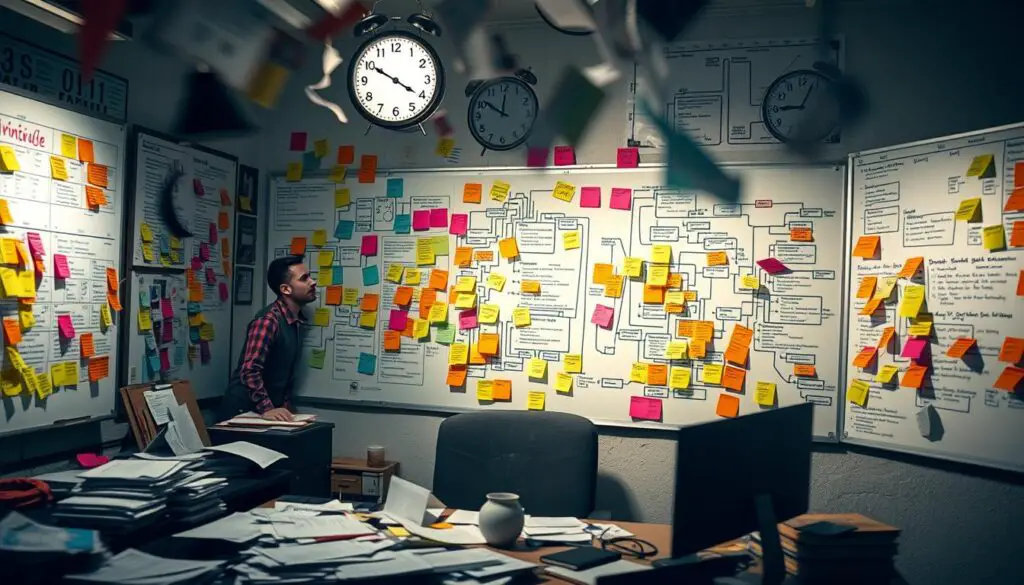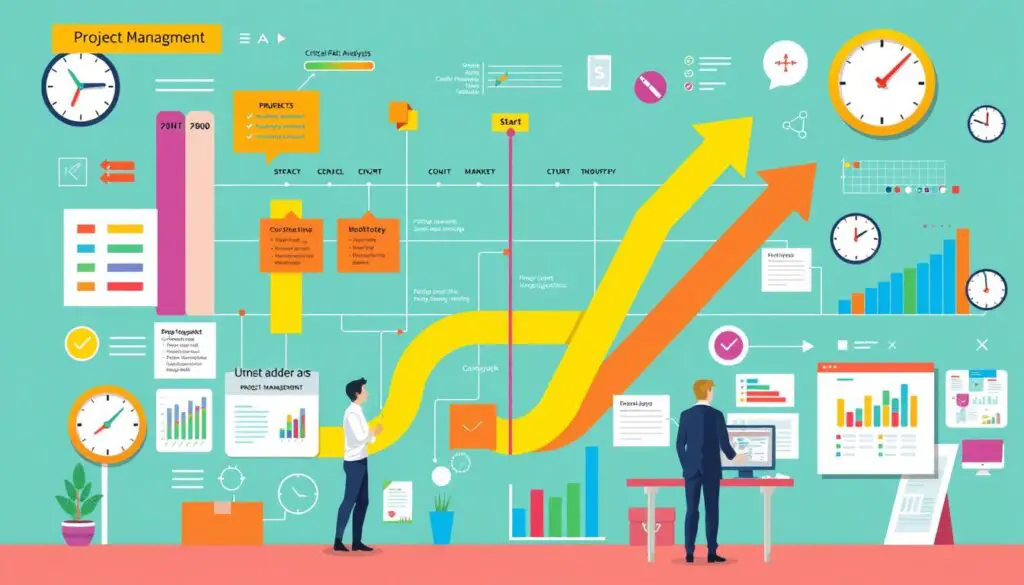Managing your time well is key in any project, even more so in Project Management Professional (PMP) work. This guide will show you 6 Critical Path Analysis Techniques for Time Management in PMP. You’ll get tips to improve your project planning and resource use. The Critical Path Method (CPM) is a structured way to manage projects. It helps you figure out project duration by breaking it down into smaller tasks.
Learning how to spot critical tasks and manage their dependencies is vital. It affects when your project will be done. The three-point estimation method gives you more accurate time estimates. Also, using the Forward and Backward Pass helps find the best start and end times. So, get ready to dive into this detailed PMP Time Management Guide. You’ll find effective PMP Project Management Techniques to make your work flow better.
Understanding Critical Path Analysis
Critical Path Analysis is key in Project Management. It shows the order and timing of tasks. It finds the critical tasks that affect the project’s timeline. Knowing the critical path helps manage time and resources better.
What is Critical Path Analysis?
Critical Path Analysis (CPA) finds the longest chain of tasks that sets the project’s minimum time. This path shows tasks needed for completion without delays. For example, a project might have tasks like:
| Activity | Duration (Days) |
|---|---|
| Design Tank Project | 10 |
| Construct Tank Foundation | 25 |
| Assemble Tank | 15 |
| Test & Commission Tank | 4 |
In this example, the critical path’s total time is 54 days. It includes different task times. By calculating the earliest start and finish times, you can track the flow and dependencies well.
Importance in Project Management
The role of Critical Path Analysis in Project Management is huge. It is vital for:
- Scheduling: Figuring out which tasks are key to meet deadlines.
- Resource Management: Managing funds and workforce based on task importance.
- Risk Assessment: Spotting risks that could delay the project.
Tasks on the critical path have no slack. This means any delay affects the whole project’s time. So, it’s important to watch these tasks closely and act quickly.
The Benefits of Using Critical Path Analysis in PMP
Using Critical Path Analysis (CPA) in project management has many benefits. It helps with scheduling and managing resources. It gives a clear plan for completing tasks on time and using resources wisely.
Enhanced Project Scheduling
CPA makes project scheduling better by showing task order and time needed. It highlights key tasks that must be done on time. This helps spot and fix delays early, saving time and money.
Using software with CPA makes managing projects more efficient. It follows the best practices for PMP Time Management.
Improved Resource Management
Good resource management means knowing which tasks need most attention. Tasks on the critical path can’t be delayed without affecting the project’s end date. Tasks not on the critical path can be adjusted.
Keeping an eye on these tasks helps use resources well. A detailed plan and diagrams make managing resources easier.
6 Critical Path Analysis Techniques for Time Management in PMP: A Guide
Effective time management is key to project success. PMP Critical Path Analysis offers a framework for this. Here are six techniques to boost your project’s efficiency and ensure timely completion.
Technique 1: Identifying Critical Tasks
It’s vital to spot tasks that are essential to your project’s timeline. These tasks, if delayed, can stop the whole project. By identifying them, you can focus resources and prioritize tasks that affect your deadline.
Technique 2: Structuring Dependencies
Organizing tasks based on their relationships is essential for planning. Knowing which tasks depend on others helps streamline workflows. This ensures tasks progress logically in your Time Management Strategies for PMP.
Technique 3: Estimating Task Durations
Accurate time estimates for each task are vital for precise scheduling. Knowing task durations helps create a reliable project timeline. It also helps spot possible bottlenecks in your project plan.
Technique 4: Creating a Network Diagram
A visual map showing task sequences and dependencies is helpful. This diagram acts as a roadmap for your project. It outlines task connections and aids in identifying the critical path.
Technique 5: Using Forward and Backward Pass Techniques
These methods help calculate project start and finish times. The Forward Pass sets the earliest start and finish dates for tasks. The Backward Pass finds the latest times without delaying project completion.
Technique 6: Monitoring and Adjusting the Critical Path
Regularly reviewing the critical path is vital for adapting to changes. This allows you to adjust to unexpected events. It ensures your project’s timeline stays on track.

Key Terms in Critical Path Analysis
Knowing key terms is key to understanding Critical Path Analysis (CPA). It helps you manage projects better. Here, we look at important concepts that are the base of CPA.
Critical Path
The critical path is the longest chain of tasks that decide a project’s shortest time to finish. Any delay here affects the project’s end date. For example, in the Design Tank Project, the total time for critical tasks is 54 days. Each task on this path must be done on time to avoid delays.
Float and Slack
Float or slack shows how much a task can be delayed without affecting the project timeline. Tasks on the critical path have zero slack, meaning any delay impacts the project. For instance, “Assemble Tank” has a 15-day duration and is critical, following strict schedules.
Forward and Backward Pass Techniques
CPA uses two main techniques: the forward pass and the backward pass. The forward pass finds the earliest start and finish times for tasks. The backward pass finds the latest start and finish times without delaying the project. These methods help project managers see timelines and adjust schedules. They are key to managing Float and Slack in Project Management and keeping projects on track.

Challenges in Critical Path Analysis
While Critical Path Analysis (CPA) is key in project management, it comes with its own set of challenges. These challenges can make the project path more complex. It’s vital to understand these hurdles for a project’s success.
Managing many dependencies is a big challenge, as projects get more complex. Also, handling changes in project scope or unexpected events needs quick decisions and adjusting priorities.
Managing Multiple Dependencies
In project management, tasks often depend on each other, leading to CPM Challenges. As tasks link up more, scheduling conflicts grow. Each link affects timelines and resource use, making it critical for managers to spot and solve these issues.
If these dependencies aren’t managed well, delays can happen. These delays can harm the project’s overall schedule.
Adapting to Project Changes
Projects rarely stay the same, and adapting to changes is essential. Changes in scope, resources, or unexpected issues can shift the critical path. Managers must quickly update task priorities and timelines.
Keeping an eye on the critical path helps make adjustments on time. This way, projects stay on track even when things change.

Best Practices for Effective Time Management in PMP
To get great results from your projects, using PMP Time Management Best Practices is key. Keeping an eye on the critical path helps project managers spot delays early. Making changes quickly can prevent problems and keep projects running smoothly.
Regular Monitoring and Updates
Checking your project’s critical path often can really help. It makes scheduling and using resources better. With over 60% of project managers facing challenges in resource management, staying current is important.
Using tools like the Critical Path Method (CPM) shows how tasks are connected. This is essential for Efficient Project Management.
Regular Team Communication
Good communication among team members boosts teamwork. When everyone knows their part, projects run better. Talking about task links and updates helps everyone understand their role.
Using CPM makes these connections clear. This helps teams work together well and avoid delays. It ensures projects are done on time and meet client needs.

| Practice | Benefits |
|---|---|
| Regular Monitoring | Identifies delays early; makes scheduling better. |
| Regular Communication | Boosts teamwork; makes roles clear. |
| Utilization of CPM | Manages tasks well; ensures projects are on time. |
| Active Resource Planning | Makes sure resources are available; cuts downtime. |
Practical Example of Critical Path Analysis
Learning about CPM can really boost your project management skills. This example shows how to plan a corporate event. It covers tasks, their connections, and the critical path. You’ll see how these methods work in real life.
Case Study: Planning a Corporate Event
Planning a corporate event needs many tasks done right. Key parts include:
- Designing the event theme
- Securing the venue
- Coordinating catering services
- Arranging audiovisual equipment
- Inviting guests
- Post-event follow-ups
Event managers use CPM to find key tasks and plan resources well. For example, finding a venue first is essential. This method focuses on tasks that can’t be delayed without affecting the event’s schedule.
Analyzing and Adjusting the Critical Path in the Case Study
The critical path for this event includes tasks like “Design Event Theme,” “Secure Venue,” and “Arrange Catering.” These tasks have no slack, so delays affect the event’s timing.
Here’s a breakdown of the main tasks, their durations, and dependencies:
| Task | Duration (days) | Predecessors |
|---|---|---|
| Design Event Theme | 5 | None |
| Secure Venue | 3 | Design Event Theme |
| Arrange Catering | 4 | Secure Venue |
| Coordinate Audiovisual Equipment | 2 | Secure Venue |
| Invite Guests | 3 | Secure Venue |
| Post-event Follow-ups | 2 | Invite Guests |
Using forward and backward pass techniques, we can find the earliest start and latest finish times. This helps managers adjust tasks to avoid delays. Using CPM improves management, leading to a successful event and valuable learning.
Conclusion
Understanding and using the six critical path analysis techniques is key for good time management in project management. These techniques help you manage schedules, use resources well, and finish projects on time and within budget. Studies show that using Critical Path Analysis (CPA) can greatly improve project results, showing how important PMP is in Project Management.
Also, nearly 80% of project delays come from bad planning and task order, which CPA fixes. By finding tasks with no float time, you can lower risks and adjust plans better. Companies that use CPA see a big jump in project delivery speed, proving its value in managing projects well.
Using CPA’s principles helps follow best practices and makes project management easier. The advantages are obvious: better scheduling, resource use, and focus on key tasks lead to successful projects. This ensures they meet the goals set in the planning stages.
Source Links
- 6 Critical Path Method Steps – CPMScheduling.com
- The Ultimate Guide to the Critical Path Method (CPM) | Smartsheet
- The Ultimate Guide to the Critical Path Method (CPM) | Smartsheet
- Microsoft Word – Technical Description Final.docx
- The Critical Path Method in Project Management: A Full Guide
- Critical Path Method (CPM) in Project Management
- How to Use Critical Path Method for Complete Beginners (with Examples)
- The Ultimate Guide to the Critical Path Method (CPM) | Smartsheet
- The Ultimate Guide to the Critical Path Method (CPM) | Smartsheet
- Unlocking Project Efficiency: A Comprehensive Guide to the Critical Path Method
- The Ultimate Guide to the Critical Path Method (CPM) | Smartsheet
- Critical Path Analysis: Definition, Purpose, and Examples in Construction Projects
- How to Plan Successful Projects With The Critical Path Method | Planio
- Breaking Down the Critical Path Method (CPM) in Project Management
- 6 Project Management Techniques Every Project Manager Must Know – SixSigma.us
- Critical Path Method Explained: Boost Project Efficiency
- The Ultimate Guide to the Critical Path Method (CPM) | Smartsheet
- Decoding the Critical Path Analysis in Project Management – Unichrone
- Understanding the Critical Path Method (CPM): A Comprehensive Guide
- How to find the critical path of a project in 6 steps




